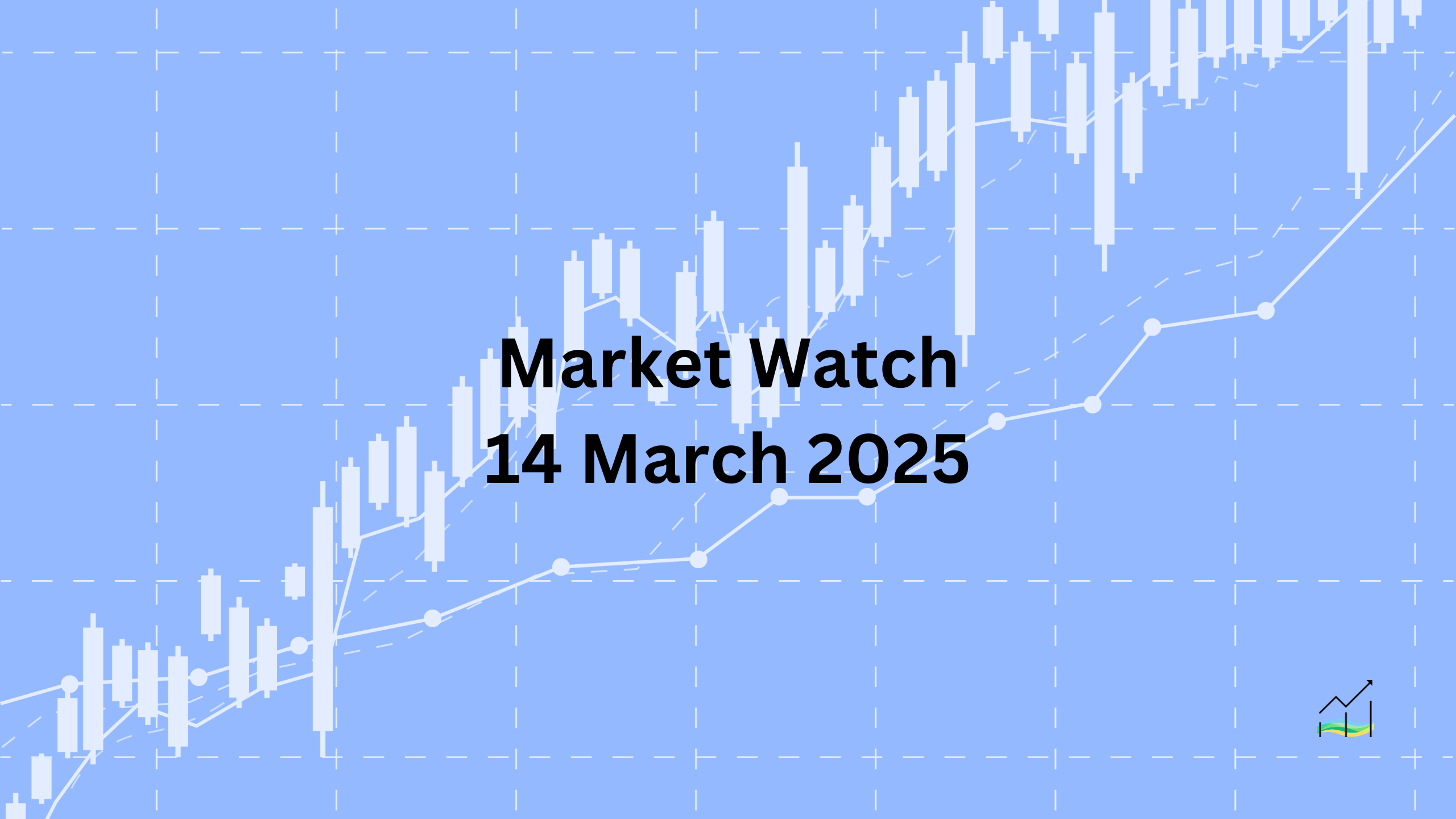14/03/2025 Market Watch

Mixed U.S. Dollar & Stronger Risk Appetite
The US dollar is showing a mixed performance as risk appetite strengthens towards the end of the week. In the foreign exchange market, dollar-bloc currencies are leading gains among G10 nations, while the Japanese yen and Swiss franc are underperforming. Japan's spring wage negotiations have yielded strong preliminary results, but a new funding scandal threatens to weaken the minority government of Prime Minister Ishida. Meanwhile, most emerging market currencies are strengthening, with the Mexican peso reaching its highest level since the US election.
In equity markets, most large Asia-Pacific indices rallied, with China's CSI 300, the Hang Seng, and mainland stocks trading in Hong Kong gaining over 2%. Europe's Stoxx 600 is up by around 0.4%, slightly reducing the week's losses. US index futures are also trading higher. European benchmark 10-year bond yields have risen slightly, up 1-2 basis points today and 2-4 basis points for the week. Similarly, the US 10-year Treasury yield has climbed by around three basis points, reaching 4.30%, with an overall increase of more than eight basis points this week.
Gold has surged to record highs near $3,000, reflecting strong investor demand. Meanwhile, May WTI crude oil remains firm but is trading within its previous range of approximately $66.10 to $67.65, after settling at around $65.70 last week.
United States of America
Overview
The Dollar Index is attempting to establish a base but remains vulnerable, struggling to regain strength above the 104.00 level. A breakout above 104.25 would signal a more significant move. The risk of a U.S. government shutdown has decreased, though bipartisan support is still required. With CPI and PPI data already released, focus shifts to upcoming economic indicators and next week’s FOMC meeting.
Economic Drivers
Several factors are influencing market sentiment and economic projections:
- The Federal Reserve's FOMC meeting is expected to keep rates unchanged, with updated forecasts providing insights into future policy direction.
- Key economic data releases, including retail sales, industrial output, and housing starts, will help assess economic momentum.
- The preliminary University of Michigan consumer survey for March will gauge confidence levels, which may be affected by policy uncertainty and recent stock market fluctuations.
- Inflation concerns persist, as February’s one-year inflation forecast surged to 4.3% from 3.3%, though this was not reflected in the NY Fed’s survey.
Data and Events
Several significant data points and events are shaping market expectations:
- FOMC Meeting – The Federal Reserve is expected to maintain its policy stance while updating economic projections.
- Retail Sales & Industrial Output – These indicators will provide insights into consumer spending and manufacturing activity.
- Housing Starts – Data will offer clues about the strength of the real estate sector.
- University of Michigan Consumer Survey – A key sentiment indicator, which may reflect concerns over policy shifts and equity market declines.
- Inflation Trends – Market-based measures and surveys suggest inflation remains a major concern.
Price Action
The Dollar Index remains under pressure, struggling to surpass 104.00. A move beyond 104.25 would be a more meaningful shift. Inflation expectations and economic data will play a crucial role in determining market direction in the coming weeks.
Key Points:
- The Dollar Index is attempting to stabilize but remains vulnerable below 104.00.
- The risk of a U.S. government shutdown has decreased, but political negotiations continue.
- The upcoming FOMC meeting will provide insights into the Fed’s policy stance.
- Retail sales, industrial output, and housing data will help assess economic momentum.
- Consumer sentiment is under pressure due to policy uncertainty and stock market movements.
- Inflation concerns persist, with mixed signals from different surveys.
Canada
Overview
The US dollar has fluctuated within last week’s range against the Canadian dollar, moving between CAD1.4240 and CAD1.4545. Trade tensions remain unresolved, keeping the Canadian dollar under pressure. The greenback briefly reached CAD1.4520 this week, close to last week's high of CAD1.4550, which aligns with a key technical retracement level. Meanwhile, Canada’s attempt to challenge US steel and aluminum tariffs at the WTO is largely symbolic, as the US has blocked the appellate process for years.
Economic Drivers
Key factors influencing the market include:
- Ongoing Trade Tensions – No immediate resolution in sight, keeping uncertainty high.
- Bank of Canada Rate Cut – A 0.25% rate cut was widely expected and had minimal market impact.
- Future Rate Expectations – Market sentiment around another rate cut has weakened, with the probability falling from 55% to 40%.
- Inflation Trends – The six-month annualized inflation rate is -1.0%, and the three-month rate is -1.2%, signaling weak price pressures.
Data and Events
The key market events shaping sentiment include:
- US Dollar Movement – The greenback tested resistance near CAD1.4520, approaching last week’s high of CAD1.4550.
- Bank of Canada’s Policy Decision – A 0.25% rate cut was in line with expectations, offering limited forward guidance.
- Market Pricing for Rate Cuts – Swaps indicate a reduced probability of a further rate cut next month.
- Canadian Inflation Data – Next week's February CPI release will be closely watched, especially given recent inflation weakness.
- Trade War Impact – Despite inflation data showing a weak trend, trade-related cost pressures remain a concern.
Price Action
The Canadian dollar remains under pressure as trade tensions persist. The US dollar’s movement around CAD1.4520-CAD1.4550 suggests a key technical resistance level. The Bank of Canada's rate cut had little impact on the currency, as it was already priced in. The upcoming CPI data may influence future rate expectations and currency direction.
Key Points:
- The US dollar fluctuated within CAD1.4240-CAD1.4545, nearing resistance.
- Trade tensions remain unresolved, weighing on the Canadian dollar.
- The Bank of Canada’s 0.25% rate cut was expected and did not impact markets significantly.
- Probability of another rate cut next month has dropped from 55% to 40%.
- Inflation remains weak, with annualized figures at -1.0% (six-month) and -1.2% (three-month).
- February CPI data next week will be a key market focus.
China
Overview
Despite ongoing market volatility, the People’s Bank of China (PBOC) has managed to maintain yuan stability. The US dollar has declined slightly this week and is down 0.9% year-to-date against the onshore yuan. Against the offshore yuan, it reached a new yearly low near CNH7.2155 before rebounding towards resistance around CNH7.26. Meanwhile, China’s February lending data fell short of expectations, but total lending this year has exceeded last year's pace. The upcoming release of January-February economic data will provide further insights into China’s economic trajectory.
Economic Drivers
Several key factors are shaping market movements and economic conditions:
- PBOC Policy – The central bank has kept the yuan steady, setting the dollar’s reference rate at CNY7.1738, near the upper end of its recent range.
- Lending Trends – February’s lending figures were lower than expected, but cumulative aggregate lending reached CNY9.29 trillion, surpassing last year’s CNY7.97 trillion.
- US-China Trade Tensions – A 20% tariff increase on Chinese goods leaves three possible outcomes:
- US importers accept lower margins.
- Prices rise, shifting the cost to consumers.
- Chinese producers absorb the cost, though Beijing resists this amid deflation concerns.
- Retail and Corporate Pressures – Walmart, sourcing 60% of its products from China, attempted to pressure Chinese manufacturers to lower prices, but Beijing pushed back.
Data and Events
Key upcoming economic reports and market developments include:
- China’s Industrial Production & Retail Sales – January-February data will indicate economic momentum at the start of the year.
- Property Investment & Housing Prices – These figures will provide insights into China’s real estate market stability.
- US Dollar Movements – The offshore yuan touched a new low at CNH7.2155, with resistance near CNH7.26.
- China’s Lending Data – The latest figures showed slower-than-expected growth but an overall stronger start compared to last year.
- Trade Tariff Adjustments – The response to increased US tariffs on Chinese goods remains a key concern for global supply chains.
Price Action
The yuan remained stable due to PBOC intervention, keeping the onshore dollar reference rate at CNY7.1738. The offshore yuan saw fluctuations, hitting a new low before rebounding. The broader market is watching trade policies and economic data releases to gauge potential impacts on currency trends.
Key Points:
- The PBOC has successfully stabilized the yuan despite market volatility.
- The US dollar fell 0.9% YTD against the onshore yuan and touched a new yearly low against the offshore yuan.
- China’s CNY9.29 trillion in total lending this year is outpacing last year’s figures.
- US tariffs on Chinese goods present pricing challenges for importers, consumers, and Chinese manufacturers.
- January-February economic data, including industrial production and retail sales, will shape market sentiment next week.
Europe
Overview
The euro's upward momentum stalled just before reaching $1.0950, pulling back to a three-day low near $1.0825. If it breaks below $1.08, further declines toward $1.0725 are likely, aligning with the 200-day moving average and the 38.2% retracement level of recent gains. With central bank meetings ahead and limited economic data scheduled, the euro's direction may depend on external factors. Meanwhile, US-German yield spreads are stabilizing after weeks of narrowing, which could weigh on the euro.
Economic Drivers
Several key factors are influencing the euro’s movement:
- US-German Yield Spread – The US two-year premium over Germany dropped from 225 basis points last month to 165 basis points earlier this week, the lowest since October. A rebound above 176 basis points could add pressure on the euro.
- Central Bank Decisions – Several major central bank meetings next week may impact global currency flows.
- German Political Developments – Ongoing negotiations over government spending, particularly on defense and debt limits, could influence market sentiment. A resolution is expected before the new Bundestag convenes on March 26.
Data and Events
The euro’s performance will be shaped by upcoming data and key events:
- US-German Yield Spread Movements – A rebound in US yields relative to German yields could weigh on the euro.
- Technical Support Levels – A break below $1.08 could trigger further losses toward $1.0725.
- Central Bank Meetings – While no major eurozone data releases are scheduled, monetary policy decisions elsewhere may influence the euro’s movement.
- German Fiscal Policy Negotiations – Discussions on defense spending and debt controls could impact economic outlooks and investor confidence.
- Bundestag Session on March 26 – A resolution on fiscal policies is expected before the new government sits, which could bring policy clarity.
Price Action
The euro's momentum has weakened, with resistance near $1.0950 and key support at $1.08. A further decline toward $1.0725 remains possible, depending on market developments. The stabilization of US-German bond spreads could also play a role in shaping future movements.
Key Points:
- The euro's rally stalled just before $1.0950, with a pullback to $1.0825.
- A break below $1.08 could lead to further declines toward $1.0725.
- The US-German yield spread has narrowed but may rebound, pressuring the euro.
- Central bank meetings next week could influence currency markets.
- German political negotiations over defense spending and debt limits are ongoing, with a resolution expected before March 26.
Japan
Overview
The Japanese yen was the only G10 currency that did not decline against the US dollar yesterday, as falling US stocks led to lower interest rates, boosting yen demand. The dollar had earlier dropped to JPY146.55, the lowest since October, but has since rebounded, testing resistance near JPY149. Despite strong wage growth in Japan, external factors, including firmer US rates and a political scandal involving Prime Minister Ishida, are influencing market sentiment.
Economic Drivers
Several factors are shaping the yen’s movement:
- US Interest Rates – Lower rates initially supported the yen, but a rebound in US yields is now favoring the dollar.
- Spring Wage Negotiations – Wages increased 5.46%, with a 3.84% rise in base pay, reflecting strong labor market conditions.
- Political Uncertainty – A new scandal involving Prime Minister Ishida, related to distributing gift vouchers to lawmakers, could impact investor confidence.
- Swiss Franc Correlation – The dollar’s strength against other low-yielding currencies, such as the Swiss franc, is further supporting its rise.
Data and Events
Key upcoming reports and market events include:
- Japan’s February Trade Figures – Insights into export and import trends will impact market sentiment.
- January Industrial Production (Final Estimate) – The initial reading showed a -1.1% month-over-month decline, and any revision could influence economic outlooks.
- Bank of Japan Meeting – No changes are expected to the 0.50% policy rate, but Governor Ueda is likely to reaffirm a cautious approach.
- Market Expectations for Rate Hikes – Swaps indicate a 50% chance of a rate hike in June, slightly lower than last week.
- US Market Trends – Movements in US stocks and bond yields will continue to affect yen dynamics.
Price Action
The dollar has rebounded from its earlier low of JPY146.55, now testing JPY149, with resistance at JPY149.20. The yen remains under pressure as US rates firm up, while ongoing political uncertainties in Japan add to market caution.
Key Points:
- The yen was the only G10 currency to hold steady as US stocks and yields declined.
- The dollar fell to JPY146.55 earlier in the week but has since recovered to JPY149.
- Japan’s wage growth showed a 5.46% increase, with a 3.84% rise in base pay.
- A political scandal involving Prime Minister Ishida could impact investor confidence.
- The Bank of Japan meeting next week is expected to maintain its 0.50% policy rate.
- Market pricing for a June rate hike in Japan has dropped slightly to 50%.
- US market trends will continue to influence yen movements in the near term.
United Kingdom
Overview
The British pound remained stable above $1.29 for the second consecutive session, despite weak economic data from the UK. Sterling recently reached its highest level since November, nearing $1.2990 on Wednesday, with the week’s low at $1.2860 on Monday. The UK economy contracted by 0.1% in January, reversing the 0.4% growth in December. However, weather disruptions may have contributed to the decline. Markets now look ahead to new government forecasts due on March 26.
Economic Drivers
Several key factors are influencing the pound’s performance:
- UK Economic Growth – The 0.1% GDP contraction in January follows a 0.4% expansion in December, raising concerns about economic momentum.
- Sector Performance –
- Industrial output fell 0.9%.
- Construction declined 0.2%.
- Services growth slowed to 0.1% from 0.4%.
- Weather Impact – January’s storms may have exaggerated economic weakness, suggesting a potential rebound.
- BOE Growth Forecasts – The Bank of England projects 0.7% GDP growth in 2025, down from 0.9% in 2024.
Data and Events
Key upcoming data and events that could impact sterling:
- New UK Government Forecasts (March 26) – Official economic projections may influence policy expectations.
- Sterling’s Performance – The pound ended February slightly above $1.2575, with last week’s close at $1.2920.
- Industrial & Services Data – Further sector reports will provide insights into the economy’s trajectory.
- Bank of England Policy Outlook – Investors will monitor central bank comments for any shifts in economic expectations.
- US Dollar Trends – Broader currency market movements may influence sterling’s strength.
Price Action
Sterling remains above $1.29, with resistance near $1.2990 and support at $1.2860. Despite weak economic data, the pound is holding steady, with market participants awaiting further guidance from the UK government and central bank.
Key Points:
- Sterling has stayed above $1.29 despite weak UK economic data.
- The UK economy shrank by 0.1% in January, reversing 0.4% growth in December.
- Industrial production fell 0.9%, while construction contracted 0.2%.
- January’s storm may have exaggerated economic weakness.
- The Bank of England projects 0.7% growth in 2025, down from 0.9% in 2024.
- UK government forecasts on March 26 may impact market sentiment.
© 2025 SKONE Enterprise (003319453-V). All rights reserved.
The content on this site is for informational purposes only and does not constitute financial advice.


